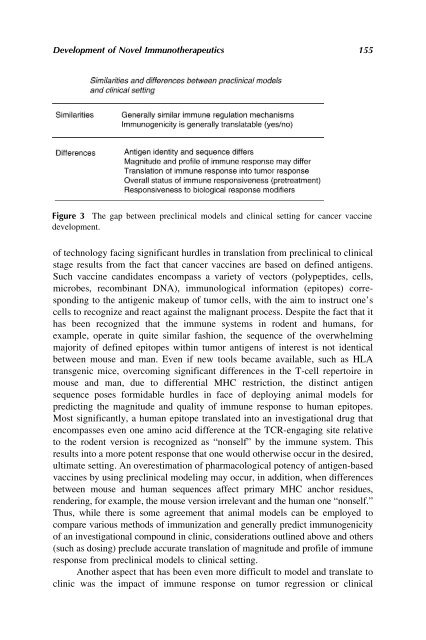Download File - JOHN J. HADDAD, Ph.D.
Download File - JOHN J. HADDAD, Ph.D.
Download File - JOHN J. HADDAD, Ph.D.
Create successful ePaper yourself
Turn your PDF publications into a flip-book with our unique Google optimized e-Paper software.
Development of Novel Immunotherapeutics 155<br />
Figure 3 The gap between preclinical models and clinical setting for cancer vaccine<br />
development.<br />
of technology facing significant hurdles in translation from preclinical to clinical<br />
stage results from the fact that cancer vaccines are based on defined antigens.<br />
Such vaccine candidates encompass a variety of vectors (polypeptides, cells,<br />
microbes, recombinant DNA), immunological information (epitopes) corresponding<br />
to the antigenic makeup of tumor cells, with the aim to instruct one’s<br />
cells to recognize and react against the malignant process. Despite the fact that it<br />
has been recognized that the immune systems in rodent and humans, for<br />
example, operate in quite similar fashion, the sequence of the overwhelming<br />
majority of defined epitopes within tumor antigens of interest is not identical<br />
between mouse and man. Even if new tools became available, such as HLA<br />
transgenic mice, overcoming significant differences in the T-cell repertoire in<br />
mouse and man, due to differential MHC restriction, the distinct antigen<br />
sequence poses formidable hurdles in face of deploying animal models for<br />
predicting the magnitude and quality of immune response to human epitopes.<br />
Most significantly, a human epitope translated into an investigational drug that<br />
encompasses even one amino acid difference at the TCR-engaging site relative<br />
to the rodent version is recognized as “nonself” by the immune system. This<br />
results into a more potent response that one would otherwise occur in the desired,<br />
ultimate setting. An overestimation of pharmacological potency of antigen-based<br />
vaccines by using preclinical modeling may occur, in addition, when differences<br />
between mouse and human sequences affect primary MHC anchor residues,<br />
rendering, for example, the mouse version irrelevant and the human one “nonself.”<br />
Thus, while there is some agreement that animal models can be employed to<br />
compare various methods of immunization and generally predict immunogenicity<br />
of an investigational compound in clinic, considerations outlined above and others<br />
(such as dosing) preclude accurate translation of magnitude and profile of immune<br />
response from preclinical models to clinical setting.<br />
Another aspect that has been even more difficult to model and translate to<br />
clinic was the impact of immune response on tumor regression or clinical

















